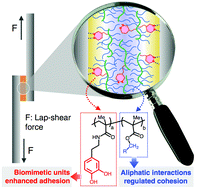Rational design of a biomimetic glue with tunable strength and ductility†
Abstract
The development of high-strength bonding materials requires a precise balance between key molecular components to allow for efficient adhesion at substrate interfaces and strong cohesive reinforcement in bulk medium. Furthermore, the cooperative tuning of both strength and adhesive ductility is desirable for achieving multiple benefits, including preventing a mismatch between adhesives and a wide-range of substrate moduli (ranging from stiff to flexible), as well as the ability to withstand mechanical load variations that may be sudden or occurring at regular intervals. This work presents a biomimetic design used to access variable strength and ductility in a next-generation adhesive. A host of random linear copolymers comprised of mussel-mimetic anchoring molecular units, and readily available alkyl methacrylates, were thoroughly investigated in order to determine the role of aliphatic interactions in macroscopic bonding. Systematic manipulations of several parameters, including alkyl chain length/structural isomers, composition ratios, and formulation conditions, were carried out to identify the optimal conditions for the best performance. Furthermore, the efficient bonding ability of these adhesives for a wide-range of substrates (e.g. metals, glass, and plastics) in both similar and dissimilar attachments, serves to demonstrate the versatility and tunable functionalities of the present strategy.



 Please wait while we load your content...
Please wait while we load your content...